Harnessing GPS Spatiotemporal Big Data to Enhance Visitor Experience and Sustainable Management of UNESCO Heritage Sites: A Case Study of Mount Huangshan, China
Abstract
1. Introduction
1.1. Background and Challenges
1.2. Literature Review
1.2.1. Types and Applications of Tourism Big Data
1.2.2. Methods for Spatiotemporal Behavior Analysis
1.3. Advantages and Contributions of This Study
2. Materials and Methods
2.1. Study Area
2.2. Research Rationale and Framework
2.3. Data Sources and Preprocessing
2.3.1. GPS Data
2.3.2. Basic Scenic Area Data
2.4. Methods
2.4.1. Density-Field Based Hotspot Detector (DF-HD)
2.4.2. Space–Time Cube (STC) Model
2.4.3. Nearest Neighbor Analysis
2.4.4. Temporal Data Preprocessing
2.4.5. Comparative Methods
- (1)
- Seasonal Intensity Index
- (2)
- Spatial Gridding Analysis
2.4.6. Innovations of This Study
3. Results
3.1. Analysis of Tourist Behavior Based on GPS Data
3.2. Tourist Interest Preferences Identified by the DF-HD Model
3.3. Space–Time Cube Analysis of Attractions and Visitor Patterns
3.4. Comparative Analysis
3.4.1. Temporal Trend and Evolution of Seasonality
3.4.2. Trajectory Density vs. Geo-Tagged Photo Grids
4. Discussion
4.1. Potential Application Scenarios
4.2. Study Limitations
4.3. Future Research Directions
5. Conclusions
Author Contributions
Funding
Data Availability Statement
Conflicts of Interest
References
- Mihalic, T. Concpetualising overtourism: A sustainability approach. Ann. Tour. Res. 2020, 84, 103025. [Google Scholar] [CrossRef]
- Li, A.; Mou, N.; Zhang, L.; Yang, T.; Liu, W.; Liu, F. Tourism Flow between Major Cities during China’s National Day Holiday: A Social Network Analysis Using Weibo Check-in Data. IEEE Access 2020, 8, 225675–225691. [Google Scholar] [CrossRef]
- Zheng, Y.; Mou, N.; Zhang, L.; Makkonen, T.; Yang, T. Chinese tourists in Nordic countries: An analysis of spatio-temporal behavior using geo-located travel blog data. Comput. Environ. Urban Syst. 2021, 85, 101561. [Google Scholar] [CrossRef]
- García-García, J.M.; Santos-Rojo, C.; Llopis-Amor, M. Overtourism and sustainability: A bibliometric study (2018–2021). Technol. Forecast. Soc. Chang. 2023, 188, 122285. [Google Scholar] [CrossRef]
- Xu, S.; Kim, H.J.; Liang, M.; Ryu, K. Interrelationships between tourist involvement, tourist experience, and environmentally responsi-ble behavior: A case study of Nansha Wetland Park, China. J. Travel Tour. Mark. 2018, 35, 856–868. [Google Scholar] [CrossRef]
- Wang, Y.; Bramwell, B. Heritage protection and tourism development priorities in Hangzhou, China: A political economy and gov-ernance perspective. Tour. Manag. 2012, 33, 988–998. [Google Scholar] [CrossRef]
- Grelaud, M.; Ziveri, P. The generation of marine litter in Mediterranean island beaches as an effect of tourism and its mitigation. Sci. Rep. 2020, 10, 20326. [Google Scholar] [CrossRef] [PubMed]
- Chen, J.; Shoval, N.; Stantic, B. Tracking tourist mobility in the big data era: Insights from data, theory, and future directions. Tour. Geogr. 2024, 26, 1381–1411. [Google Scholar] [CrossRef]
- Mehmood, F.; Ahmad, S.; Kim, D.H. Design and development of a real-time optimal route recommendation system using big data for tourists in Jeju Island. Electronics 2019, 8, 506. [Google Scholar] [CrossRef]
- Chantre-Astaiza, A.; Fuentes-Moraleda, L.; Muñoz-Mazón, A.; Ramirez-Gonzalez, G. Science mapping of tourist mobility 1980–2019. Technological advancements in the collection of the data for tourist traceability. Sustainability 2019, 11, 4738. [Google Scholar] [CrossRef]
- Zhang, Z.; Wang, F.; Deng, L. Identifying node-corridor-network of tourist flow and influencing factors using GPS big data: A case study in Gansu and Qinghai provinces, China. Int. J. Appl. Earth Obs. Geoinf. 2024, 135, 104271. [Google Scholar] [CrossRef]
- Maeda, T.N.; Yoshida, M.; Toriumi, F.; Ohashi, H. Extraction of tourist destinations and comparative analysis of preferences between foreign tourists and domestic tourists on the basis of geotagged social media data. ISPRS Int. J. Geo-Inf. 2018, 7, 99. [Google Scholar] [CrossRef]
- Mou, N.; Liu, Z.; Zheng, Y.; Makkonen, T.; Yang, T.; Zhang, L. Cycling in Tibet: An analysis of tourists’ spatiotemporal behavior and infrastructure. Tour. Manag. 2022, 88, 104418. [Google Scholar] [CrossRef]
- Zheng, W.; Li, M.; Lin, Z.; Zhang, Y. Leveraging tourist trajectory data for effective destination planning and management: A new heuristic approach. Tour. Manag. 2022, 89, 104437. [Google Scholar] [CrossRef]
- Peng, X.; Huang, Z. A novel popular tourist attraction discovering approach based on geo-tagged social media big data. ISPRS Int. J. Geo-Inf. 2017, 6, 216. [Google Scholar] [CrossRef]
- Mou, N.; Yuan, R.; Yang, T.; Zhang, H.; Tang, J.; Makkonen, T. Exploring spatio-temporal changes of city inbound tourism flow: The case of Shanghai, China. Tour. Manag. 2020, 76, 103955. [Google Scholar] [CrossRef]
- Liu, J.; Chen, J.; Law, R.; Wang, S.; Yang, L. Travel patterns and spatial structure: Understanding winter tourism by trajectory data mining. Asia Pac. J. Tour. Res. 2024, 29, 1351–1368. [Google Scholar] [CrossRef]
- Li, G.; Yuan, J.; Deng, N. Comparative study of the spatial behavior of Chinese and foreign tourists based on landmark recognition in short tourism videos: A case study of Beijing. Asia Pac. J. Tour. Res. 2024, 29, 96–112. [Google Scholar] [CrossRef]
- Vu, H.Q.; Leung, R.; Rong, J.; Miao, Y. Exploring Park Visitors’ Activities in Hong Kong using Geotagged Photos. In Information and Communication Technologies in Tourism 2016; Springer: Cham, Switzerland, 2016; pp. 183–196. [Google Scholar] [CrossRef]
- Li, Y.; Xie, J.; Gao, X.; Law, A. A Method of selecting potential development regions based on GPS and social network models–from the perspective of tourist behavior. Asia Pac. J. Tour. Res. 2021, 26, 183–199. [Google Scholar] [CrossRef]
- Ji, K.M.; Zhao, Y.; Wang, J.; Huang, X. Consuming the mundane and extraordinary: Hospitality facilities and transport in the spatio-temporal behaviour of theme park visitors. Asia Pac. J. Tour. Res. 2021, 26, 953–972. [Google Scholar] [CrossRef]
- Smallwood, C.B.; Beckley, L.E.; Moore, S.A. An analysis of visitor movement patterns using travel networks in a large marine park, north-western Australia. Tour. Manag. 2012, 33, 517–528. [Google Scholar] [CrossRef]
- Xu, D.; Cong, L.; Wall, G. Tourists’ spatio-temporal behaviour and concerns in park tourism: Giant Panda National Park, Sichuan, China. Asia Pac. J. Tour. Res. 2019, 24, 924–943. [Google Scholar] [CrossRef]
- Zhu, H. Zone division and extraction of historic area based on big data. Curr. Issues Tour. 2021, 24, 1991–2012. [Google Scholar] [CrossRef]
- Huang, Y.; Xiao, Z.; Wang, D.; Jiang, H.; Wu, D. Exploring Individual Travel Patterns across Private Car Trajectory Data. IEEE Trans. Intell. Transp. Syst. 2020, 21, 5036–5050. [Google Scholar] [CrossRef]
- Korpilo, S.; Virtanen, T.; Saukkonen, T.; Lehvävirta, S. More than A to B: Understanding and managing visitor spatial behaviour in urban forests using public participation GIS. J. Environ. Manage. 2018, 207, 124–133. [Google Scholar] [CrossRef]
- Hallo, J.C.; Beeco, J.A.; Goetcheus, C.; McGee, J.; McGehee, N.G.; Norman, W.C. GPS as a Method for Assessing Spatial and Temporal Use Distributions of Nature-Based Tourists. J. Travel Res. 2012, 51, 591–606. [Google Scholar] [CrossRef]
- Edwards, D.; Griffin, T. Understanding tourists’ spatial behaviour: GPS tracking as an aid to sustainable destination management. J. Sustain. Tour. 2013, 21, 580–595. [Google Scholar] [CrossRef]
- Ahas, R.; Aasa, A.; Mark, Ü.; Pae, T.; Kull, A. Seasonal tourism spaces in Estonia: Case study with mobile positioning data. Tour. Manag. 2007, 28, 898–910. [Google Scholar] [CrossRef]
- Saluveer, E.; Raun, J.; Tiru, M.; Altin, L.; Kroon, J.; Snitsarenko, T.; Aasa, A.; Silm, S. Methodological framework for producing national tourism statistics from mobile positioning data. Ann. Tour. Res. 2020, 81, 102895. [Google Scholar] [CrossRef]
- Bao, M.; Yang, N.; Zhou, L.; Lao, Y.; Zhang, Y.; Tian, Y. The spatial analysis of weibo check-in data-The case study of Wuhan. Commun. Comput. Inf. Sci. 2013, 399 Pt 2, 480–491. [Google Scholar] [CrossRef]
- Zhou, L.; Bao, M.; Yang, N.; Lao, Y.; Zhang, Y.; Tian, Y. Spatio-temporal analysis of weibo check-in data based on spatial data ware-house. Commun. Comput. Inf. Sci. 2013, 399 Pt 1, 466–479. [Google Scholar] [CrossRef]
- Alfred, R.; Chen, Z.; Eboy, O.V.; Luxuan, Z.; Renjie, L. Analyzing trends in the spatial-temporal visitation patterns of mainland Chi-nese tourists in Sabah, Malaysia based on Weibo social big data. Heliyon 2023, 9, e15526. [Google Scholar] [CrossRef] [PubMed]
- Traunmueller, M.W.; Johnson, N.; Malik, A.; Kontokosta, C.E. Digital footprints: Using WiFi probe and locational data to analyze hu-man mobility trajectories in cities. Comput. Environ. Urban Syst. 2018, 72, 4–12. [Google Scholar] [CrossRef]
- Grinberger, A.Y.; Shoval, N.; McKercher, B. Typologies of tourists’ time-space consumption: A new approach using GPS data and GIS tools. Tour. Geogr. 2014, 16, 105–123. [Google Scholar] [CrossRef]
- Wang, M.; Liu, J.; Zhang, S.; Zhu, H.; Zhang, X. Spatial pattern and micro-location rules of tourism businesses in historic towns: A case study of Pingyao, China. J. Destin. Mark. Manag. 2022, 25, 100721. [Google Scholar] [CrossRef]
- Shoval, N.; Isaacson, M. Sequence alignment as a method for human activity analysis in space and time. Ann. Assoc. Am. Geogr. 2007, 97, 282–297. [Google Scholar] [CrossRef]
- Taczanowska, K.; González, L.M.; Garcia-Massó, X.; Muhar, A.; Brandenburg, C.; Toca-Herrera, J.L. Evaluating the structure and use of hiking trails in recreational areas using a mixed GPS tracking and graph theory approach. Appl. Geogr. 2014, 55, 184–192. [Google Scholar] [CrossRef]
- Liu, W.; Wang, B.; Yang, Y.; Mou, N.; Zheng, Y.; Zhang, L.; Yang, T. Cluster analysis of microscopic spatio-temporal patterns of tourists’ movement behaviors in mountainous scenic areas using open GPS-trajectory data. Tour. Manag. 2022, 93, 104614. [Google Scholar] [CrossRef]
- Li, Y.; Yang, L.; Shen, H.; Wu, Z. Modeling intra-destination travel behavior of tourists through spatio-temporal analysis. J. Destin. Mark. Manag. 2019, 11, 260–269. [Google Scholar] [CrossRef]
- Huang, X.; Wu, B. Intra-attraction Tourist Spatial-Temporal Behaviour Patterns. Tour. Geogr. 2012, 14, 625–645. [Google Scholar] [CrossRef]
- Gu, Q.; Zhang, H.; Huang, S.; Zheng, F.; Chen, C. Tourists’ spatiotemporal behaviors in an emerging wine region: A time-geography perspective. J. Destin. Mark. Manag. 2021, 19, 100513. [Google Scholar] [CrossRef]
- Liu, J.; Li, X.; Yang, Y.; Tan, Y.; Geng, T.; Wang, S. Short- and long-term prediction and determinant analysis of tourism flow networks: A novel steady-state Markov chain method. Tour. Manag. 2025, 109, 105139. [Google Scholar] [CrossRef]
- Wang, S.; Yang, Y.; Tan, Y.; Chen, J.; Hu, S.; Liu, J. Dynamic evolution of spatiotemporal behavioral patterns in desert tourism: Insights from big trajectory data. Asia Pac. J. Tour. Res. 2025; ahead of print. [Google Scholar] [CrossRef]
- Yun, H.J.; Kang, D.J.; Lee, M.J. Spatiotemporal distribution of urban walking tourists by season using GPS-based smartphone application. Asia Pac. J. Tour. Res. 2018, 23, 1047–1061. [Google Scholar] [CrossRef]
- Korpilo, S.; Virtanen, T.; Lehvävirta, S. Smartphone GPS tracking—Inexpensive and efficient data collection on recreational move-ment. Landsc. Urban Plan. 2017, 157, 608–617. [Google Scholar] [CrossRef]
- Kuo, C.L.; Chan, T.C.; Fan, I.C.; Zipf, A. Efficient method for POI/ROI discovery using Flickr geotagged photos. ISPRS Int. J. Geo-Inf. 2018, 7, 121. [Google Scholar] [CrossRef]
- Xu, D.; Cong, L.; Wall, G. Visitors’ spatio-temporal behavior at a zoo in China. Asia Pac. J. Tour. Res. 2020, 25, 931–947. [Google Scholar] [CrossRef]
- Mou, N.; Zheng, Y.; Makkonen, T.; Yang, T.; Tang, J.; Song, Y. Tourists’ digital footprint: The spatial patterns of tourist flows in Qing-dao, China. Tour. Manag. 2020, 81, 104151. [Google Scholar] [CrossRef]
- Su, X.; Spierings, B.; Dijst, M.; Tong, Z. Analysing trends in the spatio-temporal behaviour patterns of mainland Chinese tourists and residents in Hong Kong based on Weibo data. Curr. Issues Tour. 2020, 23, 1542–1558. [Google Scholar] [CrossRef]
- Li, Y.; Luo, P.; Li, R. Study on Spatial Distribution Characteristics of Tourists in Xiazhangquan Area Based on Geographical Indica-tion Photos. J. Fujian Norm. Univ. (Nat. Sci. Ed.) 2020, 36, 93–100. (In Chinese) [Google Scholar]
- Ferreira, A.P.G.; Silva, T.H.; Loureiro, A.A.F. Uncovering spatiotemporal and semantic aspects of tourists mobility using social sensing. Comput. Commun. 2020, 160, 240–252. [Google Scholar] [CrossRef]
- Liu, J.; Wang, S.; Law, R.; Chen, J.; Yang, L. Growing threat of marine tourism activities to whales: Evidence from vessel trajectory big data mining. J. Sustain. Tour. 2025; ahead of print. [Google Scholar] [CrossRef]
- Xu, X.; Hu, J. Study on Spatiotemporal Behavior of Urban Park Tourists Based on GPS Data:A Case Study of Wuhan East Lake Scenic Area. Econ. Geogr. 2020, 40, 224–232. (In Chinese) [Google Scholar]
- Lu, J.; Huang, X.; Kupfer, J.A.; Xiao, X.; Li, Z.; Wei, H.; Wang, S.; Zhu, L. Spatial, temporal, and social dynamics in visitation to U.S. national parks: A big data approach. Tour. Manag. Perspect. 2023, 48, 101143. [Google Scholar] [CrossRef]
- Zhang, Y.; Zhang, Z.; Li, Y.; Xiao, L. Consensus Map Analysis of Tourist Destination Image in Mountain Scenic Spots: A Case Study of Huangshan Mountain. Tour. Res. 2024, 16, 57–69. (In Chinese) [Google Scholar]
- Huang, C.; Wang, Q. A Study on Residents’Perception of Ecological Justice and Spatial Differences in Tourism Community: A Case Study of the Gateway Communities of Huangshan Scenic Area. Tour. Sci. 2024, 38, 59–79. (In Chinese) [Google Scholar] [CrossRef]
- Xu, J.; Wang, Q. The relationship between eco-emotions and environmental responsibility behaviors of tourists in natural tourist destinations: A case study of Huangshan Scenic Area. J. Chin. Ecotourism 2024, 14, 359–374. (In Chinese) [Google Scholar] [CrossRef]
- Huang, W.; Zhang, Y.; Wu, M.; Dang, A. Tourist Behavioral Analysis of Smart National Park Based on WiFi Positioning Data: Case Study on Huangshan National Park. Chin. Landsc. Archit. 2018, 3, 25–31. [Google Scholar]
- Zeng, X.; Zhong, Y.; Yang, L.; Wei, J.; Tang, X. Analysis of Forest Landscape Preferences and Emotional Features of Chinese Forest Recreationists Based on Deep Learning of Geotagged Photos. Forests 2022, 13, 892. [Google Scholar] [CrossRef]
- Zhang, H.; Zhou, X.; Tang, G.; Zhou, L.; Ye, X. Hotspot discovery and its spatial pattern analysis for catering service in cities based on field model in GIS. Geogr. Res. 2020, 39, 354–369. (In Chinese) [Google Scholar]
- Hu, Y.; Ma, X.; Liu, J.; Liu, Y. Similarity of Spatio-temporal Behavior of Tourists in Island-based Destinations Based on GPS Data: A Case Study of Changdao Island in Shandong Province. Sci. Geogr. Sin. 2022, 42, 1954–1962. (In Chinese) [Google Scholar] [CrossRef]
- Lu, L. A study on the tourist flows in mountain resorts—A case study in Huangshan mountain. ACTA Geogr. Sin. 1994, 49, 237–246. (In Chinese) [Google Scholar]
- Wang, D.; Lu, L.; Liu, C.; Zhang, J.; Ling, S. Temporal and Spatial Characteristics of Domestic Tourist Flows to Mountain Resorts. J. Mt. Sci. 2004, 22, 625–632. (In Chinese) [Google Scholar]
- Liashkov, S. Identifying High-Risk Areas for Traffic Collisions in Montgomery, Maryland Using KDE and Spatial Autocorrelation Analysis. arxiv 2025, arXiv:2506.21930. [Google Scholar]
- Rengarasu, T.M.; Arunodi, H.K.I. Identification of Traffic Accident Hotspots using Network Kernel Density: Application to Galle District in Sri Lanka. J. South Asian Logist. Transp. 2025, 5, 1–23. [Google Scholar] [CrossRef]
- Hu, Y.; Linsheng, Z.; Qi, W. Identification and analysis of conservation gap of national nature reserves in China. Ecol. Indic. 2024, 158, 111525. [Google Scholar] [CrossRef]
- Yang, L.; Xu, H.; Pan, S.; Chen, W.; Zeng, J. Identifying the impact of global human activities expansion on natural habitats. J. Clean. Prod. 2024, 434, 140247. [Google Scholar] [CrossRef]
- Khan, A.; Chandran, N.; Gangodkar, D. Geospatial analysis of crime patterns and hotspots for crime prevention using deep learning algorithms. EDPACS, 2025; ahead of print. [Google Scholar] [CrossRef]
- Taha, O.I.B.; Shafiq, M.O. Combining the richness of GIS techniques with visualisation tools to better understand the spatial distri-bution of data—A case study of Chicago City crime analysis. Int. J. Big Data Intell. 2020, 7, 29. [Google Scholar] [CrossRef]
- Wang, Y.; Chen, X.; Xue, F. A Review of Bayesian Spatiotemporal Models in Spatial Epidemiology. ISPRS Int. J. Geo-Inf. 2024, 13, 97. [Google Scholar] [CrossRef]
- Jiao, L.; Shen, T.; Han, Y.; Liu, W.; Liu, W.; Dang, L.; Wei, M.; Yang, Y.; Guo, J.; Miao, M.; et al. The spatial-temporal distribution of hepatitis B virus infection in China, 2006–2018. BMC Infect. Dis. 2024, 24, 811. [Google Scholar] [CrossRef] [PubMed]
- Bigné, E.; Zanfardini, M.; Andreu, L. How online reviews of destination responsibility influence tourists’ evaluations: An exploratory study of mountain tourism. J. Sustain. Tour. 2020, 28, 686–704. [Google Scholar] [CrossRef]
- Zhang, K.; Chen, Y.; Lin, Z. Mapping destination images and behavioral patterns from user-generated photos: A computer vision approach. Asia Pac. J. Tour. Res. 2020, 25, 1199–1214. [Google Scholar] [CrossRef]

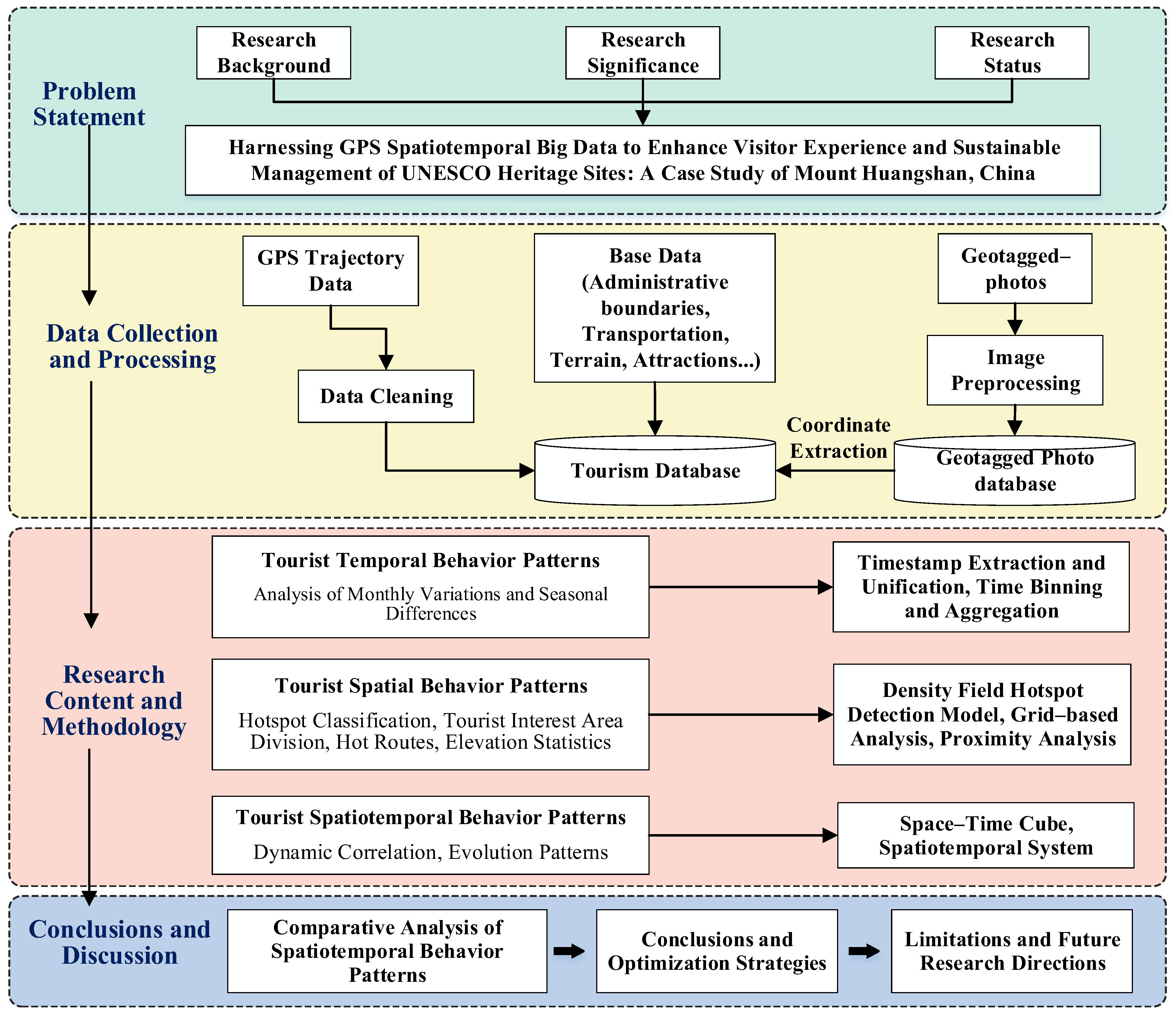
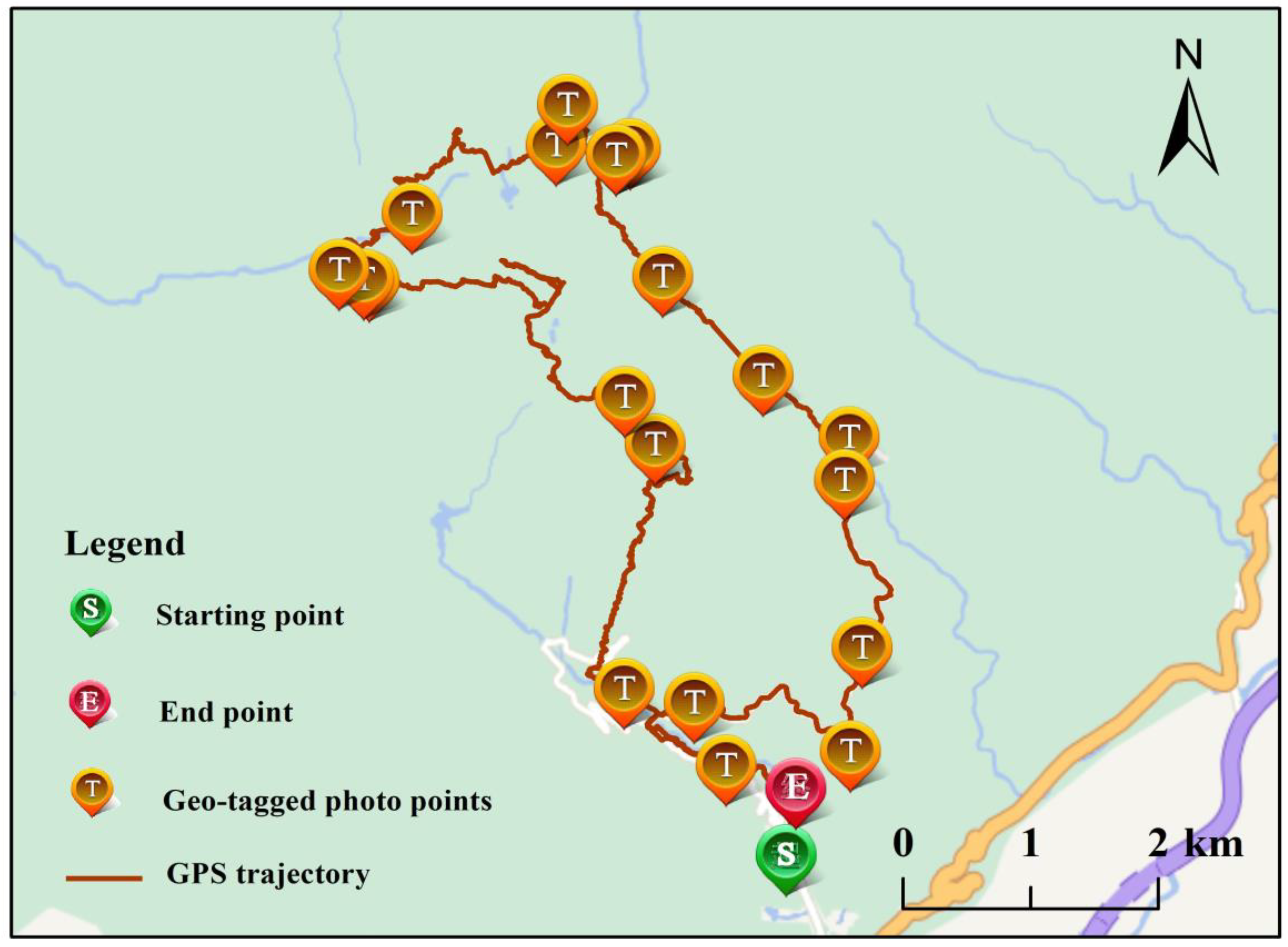

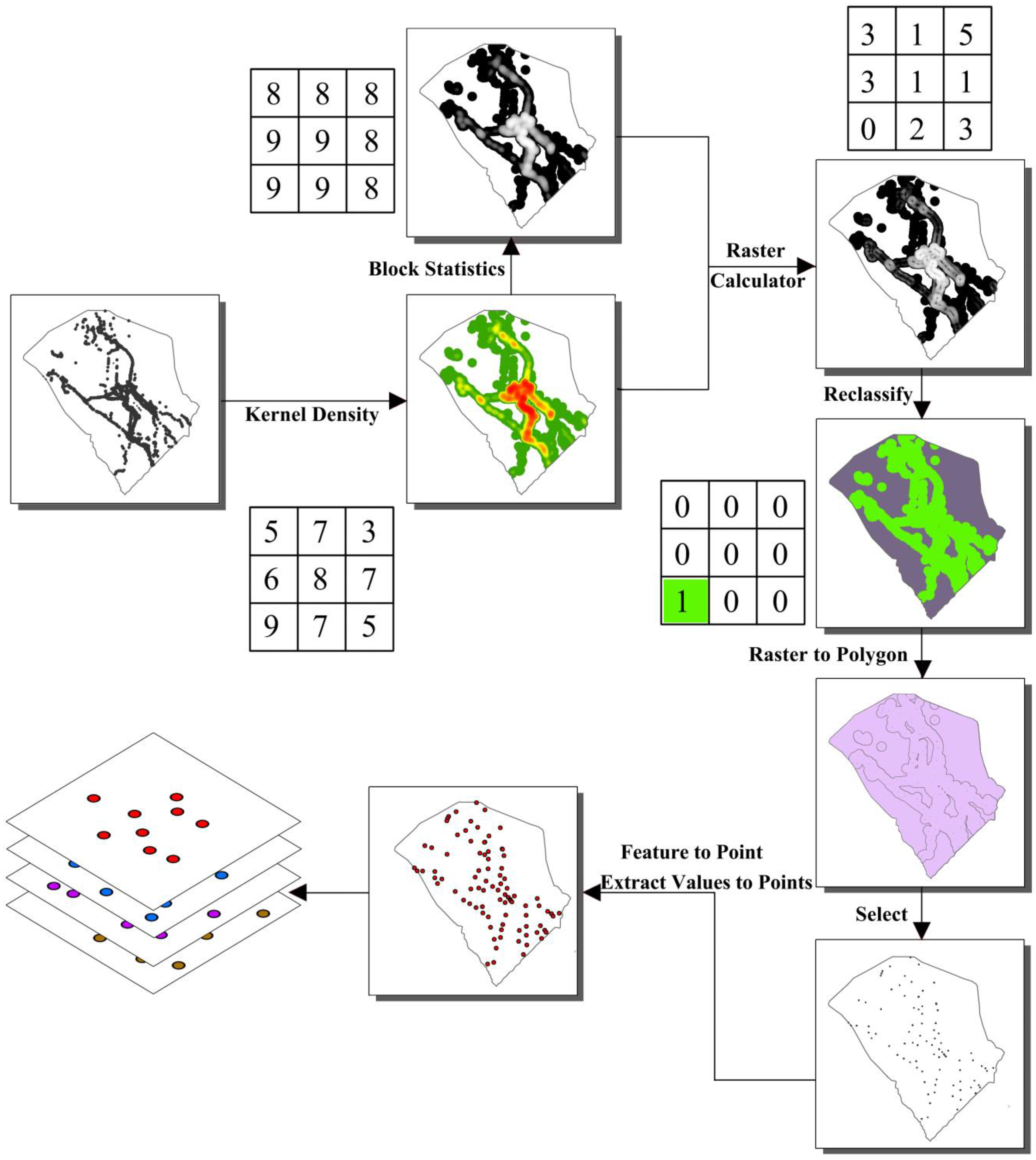

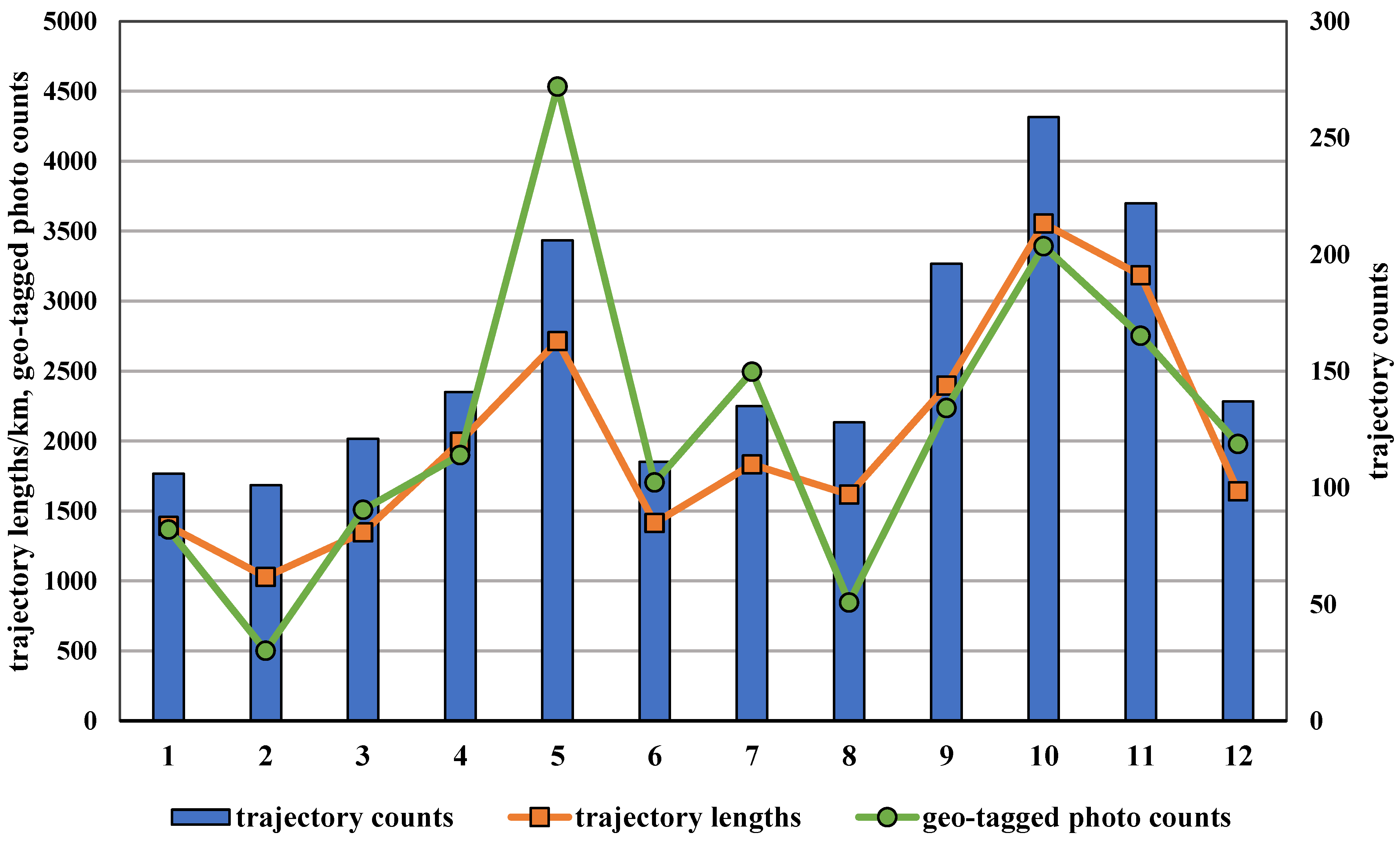
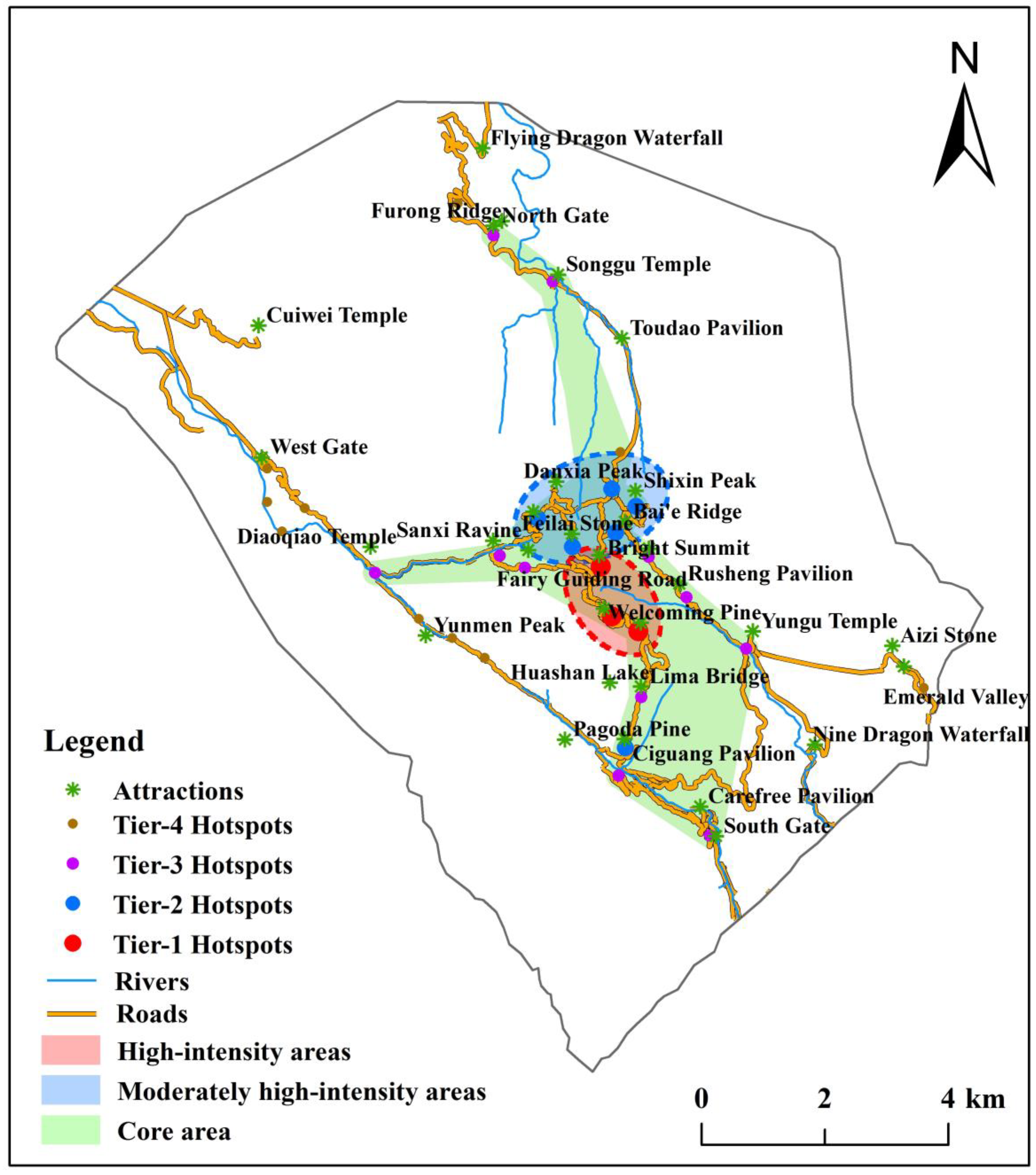
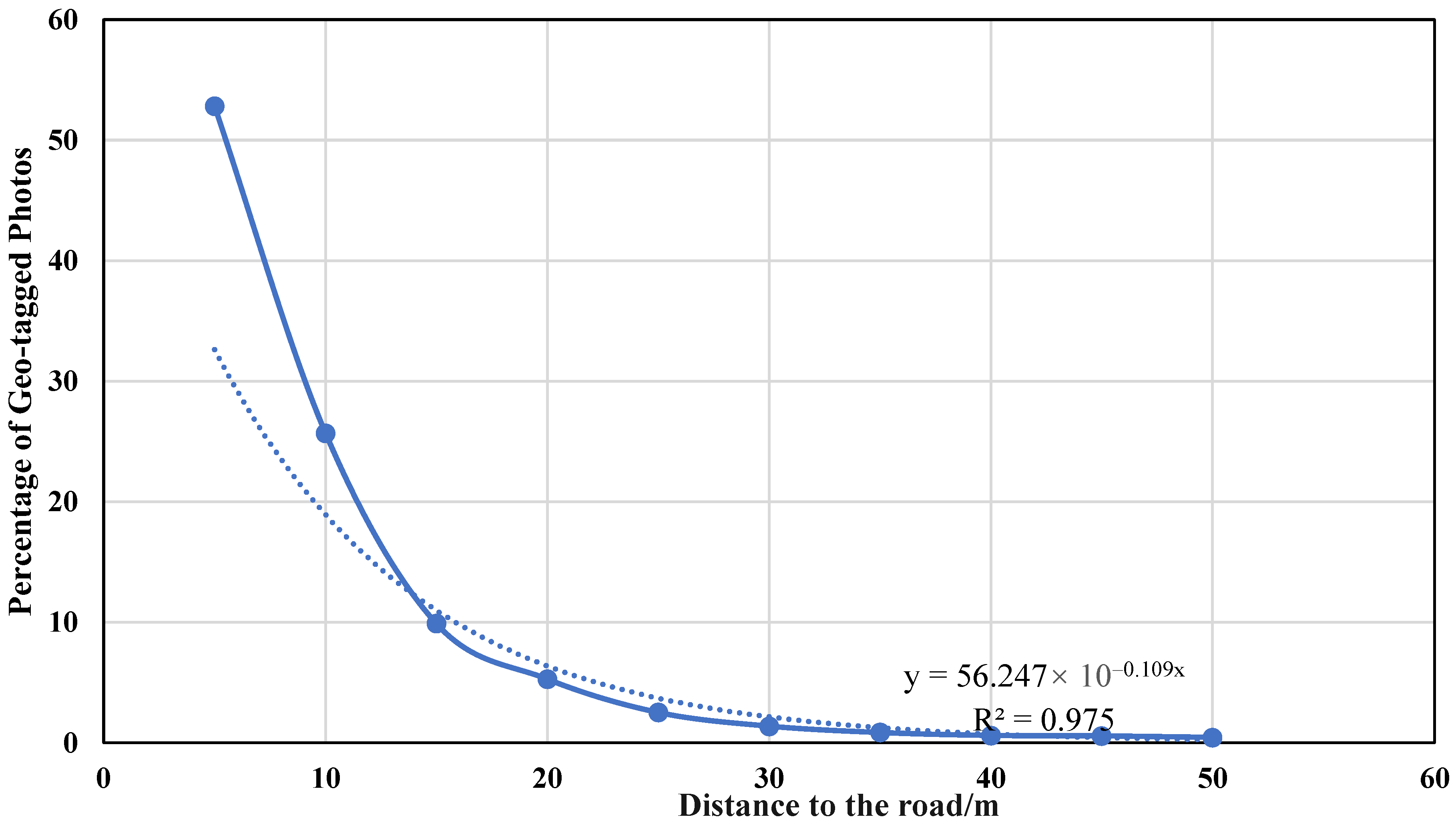
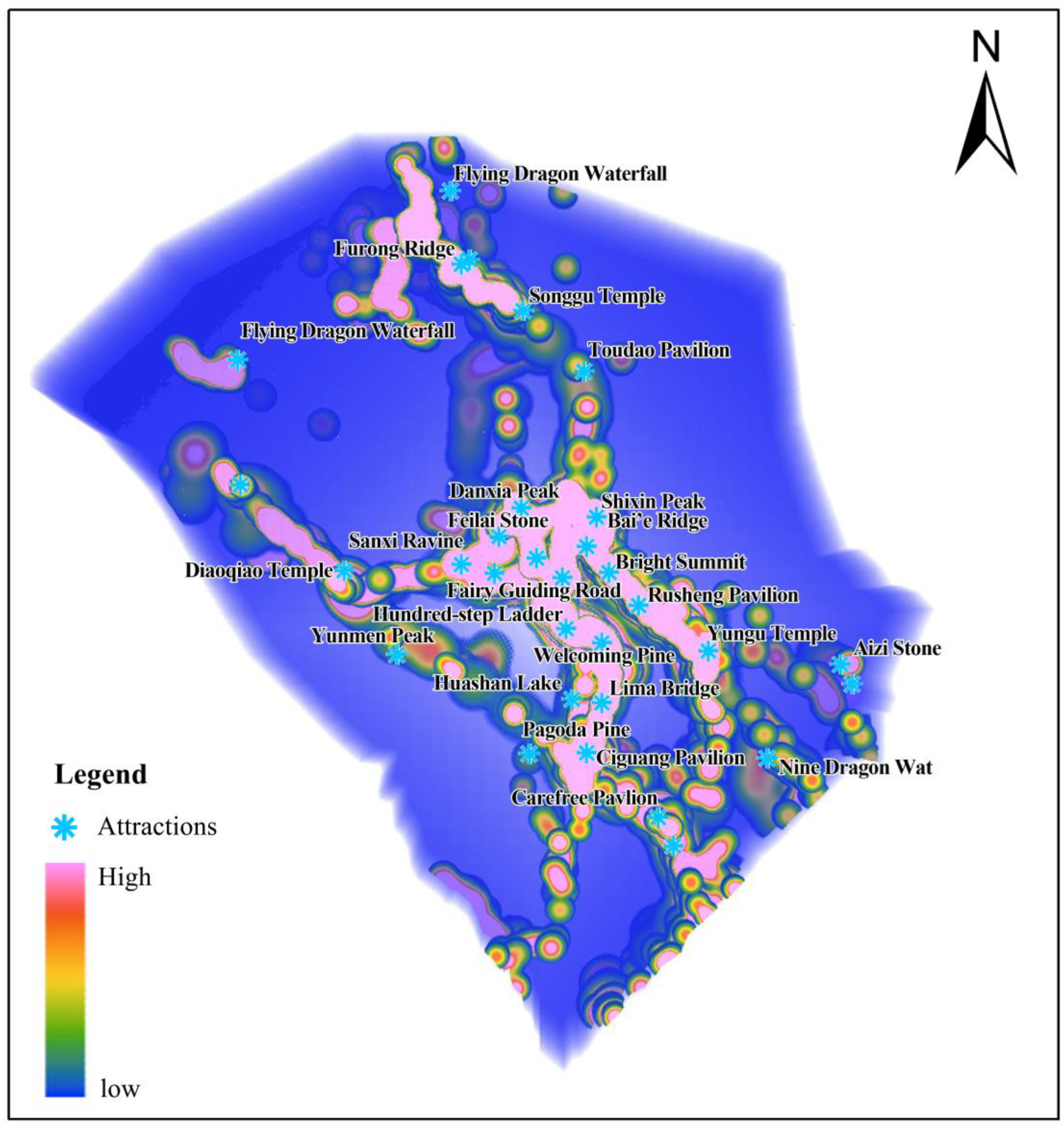


| Study Object | Data Source | Main Method(s) | Reference |
|---|---|---|---|
| Route patterns | GPS | Kernel density estimation (KDE), standard deviational ellipse | [26] |
| Attraction popularity | GPS | Point density | [27] |
| Visitor distribution | GPS | Overlay analysis | [28] |
| Seasonal variation | Mobile signaling | Spatial interpolation, principal component analysis | [29] |
| Cross-border tourism | Mobile signaling | Linear regression | [30] |
| Block-level heat | Analytic hierarchy process (AHP), point density | [31] | |
| Trip duration | temporal statistics | [32] | |
| Behavioral preferences | KDE, standard deviational ellipse | [33] | |
| Population mobility | Wi-Fi | Clustering, network analysis | [34] |
| Visitor spending types | GPS | Space–time prism, clustering | [35] |
| Attraction popularity | Enterprise data | Standard deviational ellipse, Getis–Ord Gi* | [36] |
| Route patterns | GPS | Sequence alignment | [37] |
| Route patterns | GPS | Graph-theoretic methods, network analysis | [38] |
| Transfer patterns | GPS | Markov chains, clustering | [39] |
| Destination choice | GPS + survey | Multinomial logit (MNL) | [40] |
| Trip duration | GPS | Clustering | [41] |
| Route patterns | GPS + survey | Clustering, space–time prism | [42] |
| Tourism-flow network | GPS | Steady-state Markov chain | [43] |
| Route patterns | GPS | Clustering, similarity computation | [44] |
| Attraction popularity & dwell | GPS | KDE | [45] |
| Attraction popularity | GPS | KDE, clustering | [46] |
| POI/ROI | Geo-tagged photos | Spatial overlap algorithm | [47] |
| Route patterns | GPS | Clustering | [48] |
| Tourist flows | Travel diaries | Network analysis, concentration analysis | [49] |
| Attraction popularity | KDE, temporal statistics | [50] | |
| Attraction popularity | Geo-tagged photos | Getis–Ord Gi*, KDE | [51] |
| Trip frequency | Spatial statistics | [52] | |
| Trip frequency | GPS | Geographically weighted regression (GWR), spatial gridding | [53] |
| Trip duration | GPS + geo-tagged photos | Spatial gridding, nearest-neighbor analysis | [54] |
| Trip duration | SafeGraph | Poisson regression | [55] |
| Vertical Belt | Elevation (m) | POIs (Count) | Share (%) |
|---|---|---|---|
| Low-elevation transport belt | <400 | 159 | 0.71 |
| 400–500 | 316 | 1.41 | |
| 500–600 | 700 | 3.13 | |
| 600–700 | 521 | 2.33 | |
| 700–800 | 543 | 2.42 | |
| 800–900 | 725 | 3.24 | |
| 900–1000 | 586 | 2.62 | |
| Mid-elevation connection belt | 1000–1100 | 332 | 1.48 |
| 1100–1200 | 590 | 2.63 | |
| 1200–1300 | 406 | 1.81 | |
| 1300–1400 | 708 | 3.16 | |
| 1400–1500 | 1100 | 4.91 | |
| High-elevation core concentration | 1500–1600 | 2739 | 12.23 |
| 1600–1700 | 7180 | 32.06 | |
| 1700–1800 | 4923 | 21.98 | |
| High-elevation core concentration | >1800 | 869 | 3.88 |
| Hotspot Type | High-Heat Attractions | Moderate-High-Heat Attractions | Moderate-Heat Attractions | Low-Heat Attractions |
|---|---|---|---|---|
| Attractions (Descending Order of Heat) | Welcoming Pine, Hundred-step Cloud Ladder, Bright Summit | Shixin Peak, Dreamland, Feilai Stone, Ciguang Pavilion, Bai’e Ridge, Immortal Guiding | Yungu Temple, West Sea Grand Canyon, Lima Bridge, Sanxi Mouth, Rusheng Pavilion, Diao Bridge Temple, Songgu Temple | Other Attraction |
Disclaimer/Publisher’s Note: The statements, opinions and data contained in all publications are solely those of the individual author(s) and contributor(s) and not of MDPI and/or the editor(s). MDPI and/or the editor(s) disclaim responsibility for any injury to people or property resulting from any ideas, methods, instructions or products referred to in the content. |
© 2025 by the authors. Published by MDPI on behalf of the International Society for Photogrammetry and Remote Sensing. Licensee MDPI, Basel, Switzerland. This article is an open access article distributed under the terms and conditions of the Creative Commons Attribution (CC BY) license (https://creativecommons.org/licenses/by/4.0/).
Share and Cite
Sun, J.; Chen, S.; Huang, Y.; Rong, H.; Li, Q. Harnessing GPS Spatiotemporal Big Data to Enhance Visitor Experience and Sustainable Management of UNESCO Heritage Sites: A Case Study of Mount Huangshan, China. ISPRS Int. J. Geo-Inf. 2025, 14, 396. https://doi.org/10.3390/ijgi14100396
Sun J, Chen S, Huang Y, Rong H, Li Q. Harnessing GPS Spatiotemporal Big Data to Enhance Visitor Experience and Sustainable Management of UNESCO Heritage Sites: A Case Study of Mount Huangshan, China. ISPRS International Journal of Geo-Information. 2025; 14(10):396. https://doi.org/10.3390/ijgi14100396
Chicago/Turabian StyleSun, Jianping, Shi Chen, Yinlan Huang, Huifang Rong, and Qiong Li. 2025. "Harnessing GPS Spatiotemporal Big Data to Enhance Visitor Experience and Sustainable Management of UNESCO Heritage Sites: A Case Study of Mount Huangshan, China" ISPRS International Journal of Geo-Information 14, no. 10: 396. https://doi.org/10.3390/ijgi14100396
APA StyleSun, J., Chen, S., Huang, Y., Rong, H., & Li, Q. (2025). Harnessing GPS Spatiotemporal Big Data to Enhance Visitor Experience and Sustainable Management of UNESCO Heritage Sites: A Case Study of Mount Huangshan, China. ISPRS International Journal of Geo-Information, 14(10), 396. https://doi.org/10.3390/ijgi14100396






